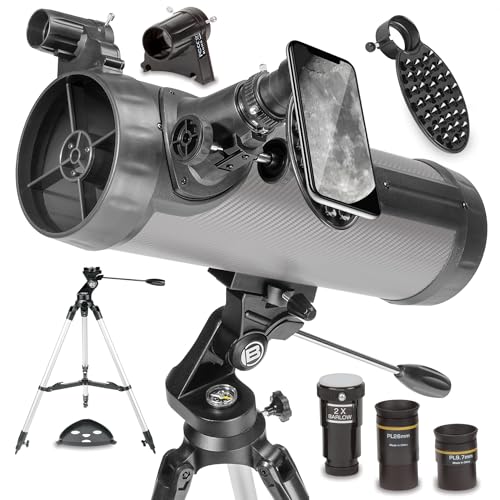Embarking on a celestial journey with the Orion SpaceProbe 130ST Equatorial Reflector Telescope has been an incredible experience, and I’m thrilled to share my insights after extensive use.
For years, I’ve dreamt of exploring the night sky beyond what my naked eye could offer. The vastness of space, the mystery of distant galaxies – it all felt tantalizingly out of reach. I knew a good telescope was the key, but the sheer number of options available was overwhelming. I worried about making the wrong choice, investing in a product that wouldn’t deliver the promised celestial views. A powerful, yet user-friendly telescope was crucial – something that wouldn’t intimidate a novice like myself, but would still allow for growth and exploration.
- This 5.1" aperture reflector telescope gathers an ample amount of light for great views of the planets and Moon, as well as brighter galaxies, nebulas, and star clusters
- Compact optical tube design for easy portability and fast f/5 focal ratio for pleasing wide-field performance makes the SpaceProbe 130ST EQ a very versatile telescope the whole family can enjoy
- Sturdy equatorial telescope mount and adjustable tripod allows manual slow-motion tracking of celestial objects as they appear to migrate across the night sky
Choosing Your Stargazing Companion: Factors to Consider
Stepping into the world of telescopes requires careful consideration. What are your primary goals? Are you primarily interested in planetary observation, deep-sky objects, or astrophotography? The Orion SpaceProbe 130ST type addresses many of these needs but not all. Budget is a significant factor; telescopes range from entry-level models to high-end professional instruments. Portability is another crucial aspect; consider where you’ll be observing and how easily you can transport the telescope. For beginners, a user-friendly design with clear instructions is essential. Those with limited experience might benefit from a Newtonian reflector telescope with its simplicity, whereas more advanced users might opt for more complex setups. If astrophotography is a priority, ensure your chosen telescope and mount are compatible with your camera equipment and consider additional accessories like motor drives.
- 150mm Large Aperture: Capture bright, clear, and detailed views of the night sky with a 150mm aperture and 650mm focal length. Its powerful light-gathering ability delivers sharp images—perfect for...
- PERFECT ENTRY-LEVEL TELESCOPE: The Celestron PowerSeeker 127EQ is an easy-to-use and powerful telescope. This 127mm Newtonian Reflector offers enough light gathering ability to see planets, the Moon's...
- LARGE APERTURE: This Newtonian telescope has a 114mm aperture for exploring the Moon, planets and deep sky objects.
Introducing the Orion SpaceProbe 130ST: A Closer Look
The Orion SpaceProbe 130ST Equatorial Reflector Telescope is a 5.1″ aperture reflector designed for beginner to intermediate astronomers. Its promise is clear: a portable, versatile telescope capable of delivering stunning views of planets, the Moon, and brighter deep-sky objects. The package includes two 1.25″ Plossl eyepieces (25mm and 10mm), a smartphone camera adapter, star charts, a collimation cap, and more. Compared to other entry-level telescopes, the SpaceProbe 130ST stands out with its equatorial mount, allowing for precise tracking of celestial objects. However, it may not be suitable for those solely focused on high-magnification deep-sky astrophotography due to its aperture size.
- Pros: Portable design, equatorial mount, good light gathering, versatile magnification, relatively easy setup.
- Cons: Can be slightly unwieldy to transport in one piece, some plastic components feel less robust, collimation can be challenging for first-timers.
Unveiling the Features and Benefits: A Detailed Exploration
Assembly and Setup
The assembly process, while initially daunting, is manageable. While the manufacturer suggests a 30-minute setup, allow for at least an hour, especially for first-time users. The instructions are adequate, though a few more detailed diagrams would enhance clarity for novices. I encountered minor setbacks during assembly, such as initially misinterpreting the function of the latitude adjustment bolt and attaching the tube rings to the wrong side. These initial hurdles, however, helped me understand the instrument’s mechanics better.
Collimation: Fine-Tuning for Optimal Performance
Collimation, the process of aligning the telescope’s mirrors, is crucial for achieving optimal image quality. The included collimation cap aids in this process, but it requires patience and a systematic approach. My initial attempt was adequate, but after further refinement, the images became noticeably sharper. I recommend checking the collimation upon receiving the telescope and periodically thereafter, even if there is no obvious misalignment.
Equatorial Mount: Precise Tracking of Celestial Wonders
The equatorial mount is a key feature. While it introduces a slight learning curve for beginners compared to simpler alt-azimuth mounts, it allows for precise tracking of celestial objects as they appear to move across the night sky. This makes prolonged observation much more comfortable and increases the telescope’s utility for astrophotography (though a motor drive is recommended for long exposures).
Optical Performance: Breathtaking Views of the Cosmos
The image quality is stunning. The 5.1″ aperture gathers sufficient light to reveal impressive detail on the Moon, planets, and brighter deep-sky objects. The included eyepieces provide versatility, and upgrading to higher magnification eyepieces further enhances the viewing experience. The f/5 focal ratio delivers pleasing wide-field views, beneficial for observing larger celestial objects like nebulae and star clusters.
Included Accessories: Enhancing the Stargazing Experience
The accessories included with the Orion SpaceProbe 130ST are practical and useful. The smartphone adapter facilitates astrophotography, while the star charts and software assist in locating celestial objects. The collimation cap is essential for maintaining optimal performance.
Community Voices: Real Users Share Their Experiences
Online reviews overwhelmingly praise the Orion SpaceProbe 130ST for its image quality, versatility, and ease of use for beginners. Many users highlight the stunning views of the Moon and planets, and some have successfully ventured into astrophotography with additional equipment. However, a few users note some concerns about the sturdiness of the tripod and the initial learning curve associated with the equatorial mount. These are common concerns across many telescopes in this price range.
Reaching for the Stars: A Final Verdict
The Orion SpaceProbe 130ST Equatorial Reflector Telescope has opened up a world of celestial wonder. It effectively addresses the need for a powerful yet user-friendly telescope capable of delivering stunning views. It offers exceptional value, especially for beginners looking to explore the night sky. While some minor drawbacks exist, the overall experience is overwhelmingly positive. If you’re ready to embark on your own astronomical adventure, click here to check out the Orion SpaceProbe 130ST and start your journey.
Last update on 2025-11-04 / Affiliate links / Images from Amazon Product Advertising API




